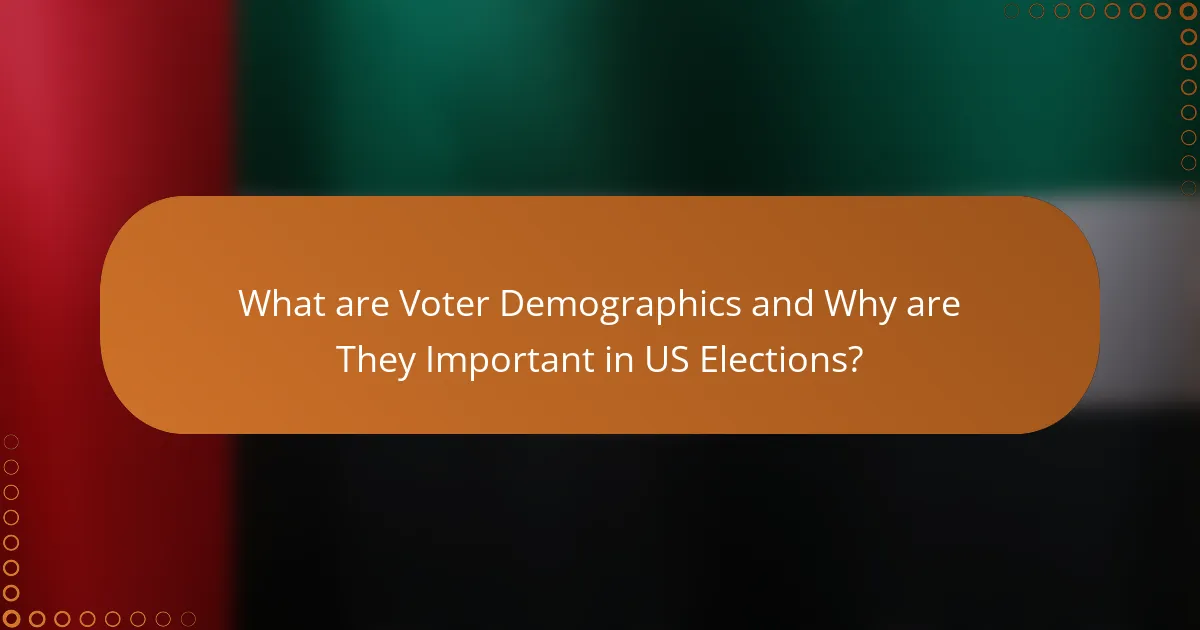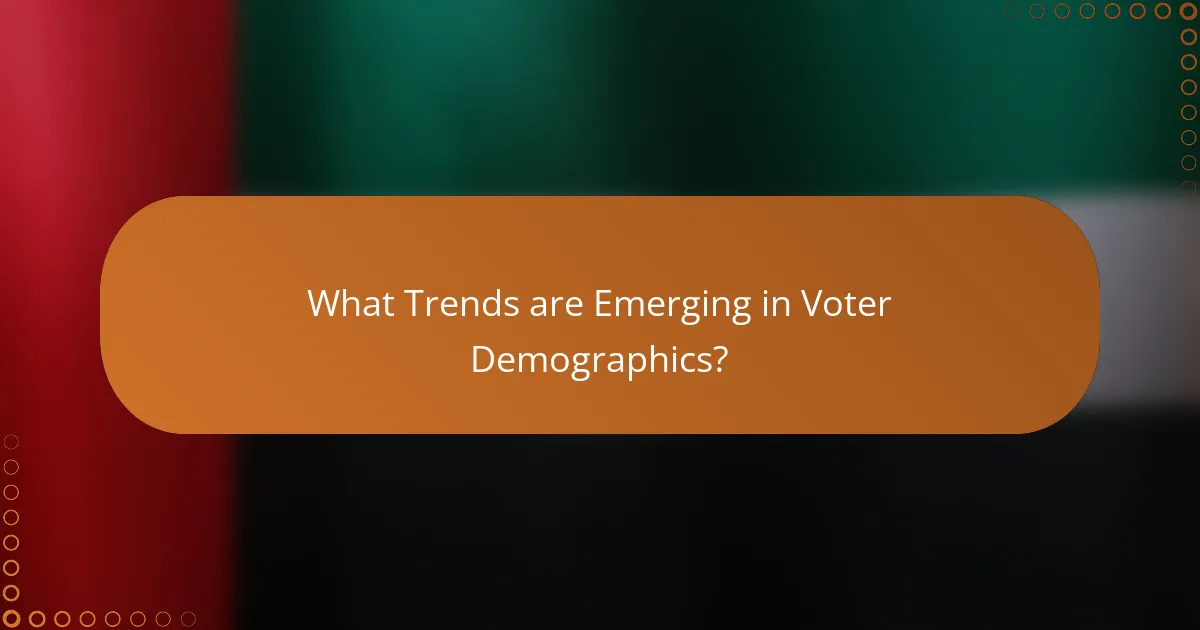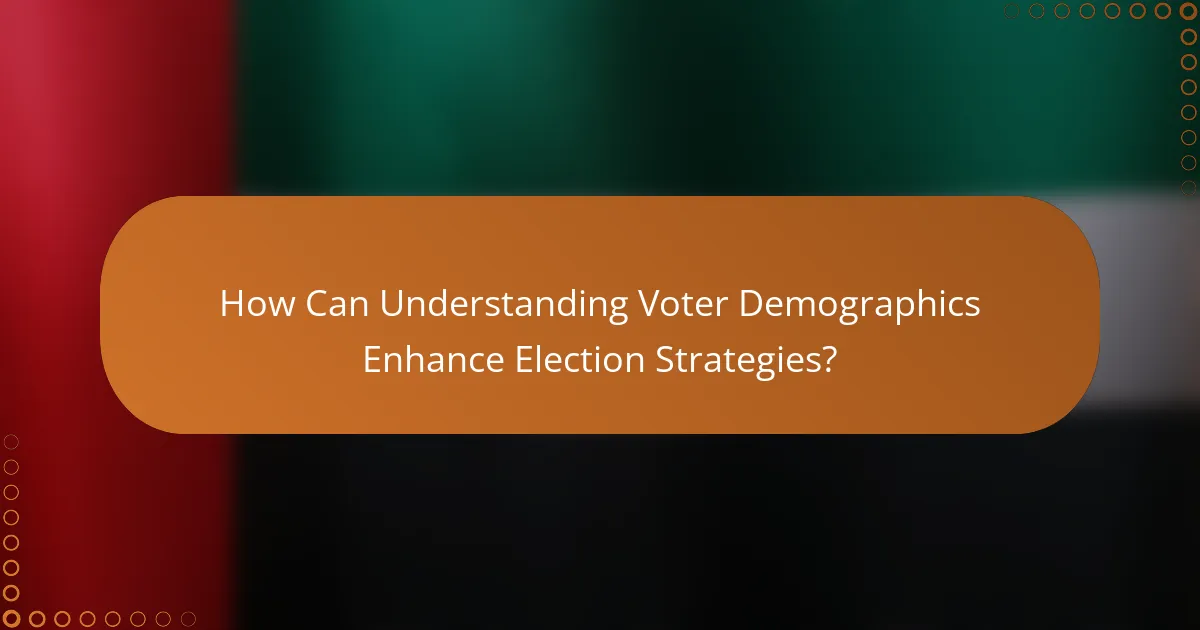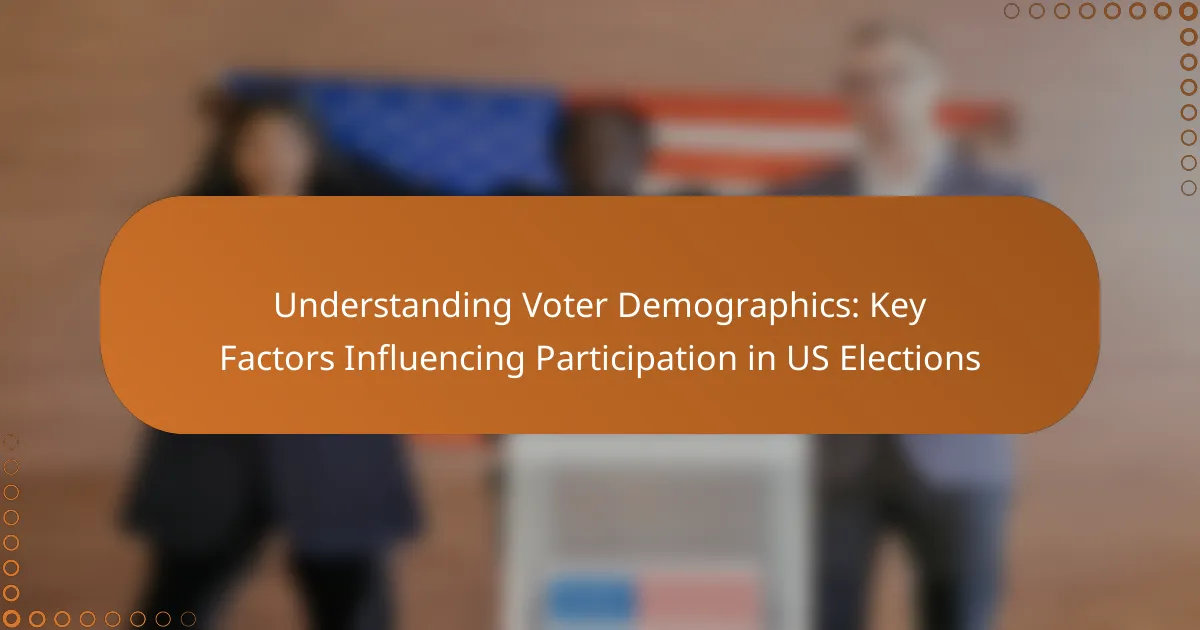Voter demographics refer to the statistical characteristics of the electorate, including factors such as age, race, gender, income, and education level, which significantly influence voting behavior and party affiliation in US elections. This article explores the importance of understanding these demographics for tailoring campaign strategies and improving voter engagement. It highlights emerging trends, such as increased political activity among younger voters and growing representation of minority groups, which are reshaping the political landscape. Additionally, the article discusses how targeted outreach based on demographic analysis can enhance election strategies and resource allocation, ultimately driving informed decision-making in the electoral process.

What are Voter Demographics and Why are They Important in US Elections?
Voter demographics are statistical characteristics of the electorate, including age, race, gender, income, and education level. They are crucial in US elections as they influence voting behavior and party affiliation. Understanding these demographics helps candidates tailor their campaigns to specific groups. For example, younger voters tend to lean Democratic, while older voters often support Republicans. According to the U.S. Census Bureau, in the 2020 election, 50% of eligible voters aged 18-29 participated, compared to 72% of those aged 65 and older. This data highlights the varying levels of engagement among different demographic groups. Analyzing voter demographics allows for targeted outreach and informed policy-making.
How do Voter Demographics Influence Election Outcomes?
Voter demographics significantly influence election outcomes by determining which candidates appeal to specific groups. Age, race, gender, education, and income are key demographic factors. For example, younger voters often lean Democratic, while older voters may favor Republicans. Racial demographics also play a critical role; minority groups tend to support progressive policies. Gender differences affect candidate support as well, with women generally favoring Democratic candidates. Education levels correlate with political preferences; higher education often aligns with liberal views. Income influences voting behavior; wealthier individuals may prioritize tax policies that benefit them. Historical data shows that demographic shifts can change electoral landscapes, as seen in the 2020 election where diverse voter turnout impacted results.
What Key Demographic Factors Affect Voter Participation?
Key demographic factors that affect voter participation include age, education, income, and race. Younger voters tend to participate less than older voters. Research shows that individuals aged 18-24 have the lowest turnout rates, often below 50%. Education significantly impacts participation; those with higher education levels are more likely to vote. According to the U.S. Census Bureau, 75% of college graduates voted in the 2020 election compared to 50% of those with only a high school diploma. Income also plays a role; higher-income individuals tend to vote at higher rates. The 2020 election data indicated that 71% of voters with incomes over $100,000 participated, compared to 57% of those earning below $30,000. Race and ethnicity influence turnout as well. Historically, minority groups have faced barriers that affect their participation, although recent trends show increased engagement among these populations.
How do Age and Gender Impact Voting Behavior?
Age and gender significantly impact voting behavior. Younger voters tend to lean towards progressive candidates. Older voters often favor conservative policies. Gender differences also play a role. Women generally support social welfare programs more than men. Men, on average, show higher support for military and defense spending. Research indicates that women are more likely to vote than men in many elections. According to the U.S. Census Bureau, in the 2020 election, 66.1% of women voted compared to 64.5% of men. Age demographics show that turnout rates increase with age. Voters aged 65 and older had a turnout rate of 75% in the 2020 election. These patterns illustrate how age and gender influence electoral choices and participation levels.
What Role Does Ethnicity Play in Voter Demographics?
Ethnicity significantly influences voter demographics in the United States. Different ethnic groups exhibit distinct voting patterns and preferences. For instance, African American voters historically lean toward Democratic candidates. In contrast, Hispanic voters show diverse preferences, often influenced by factors like immigration policy. Asian American voters tend to support Democratic candidates, though this varies by sub-group. The U.S. Census Bureau reports that minority voters are increasingly crucial in elections. In the 2020 election, 50% of Black voters and 66% of Hispanic voters supported Joe Biden. These statistics illustrate the impact of ethnicity on electoral outcomes. Ethnic identity shapes political engagement and influences party alignment.
How Do Different Ethnic Groups Participate in Elections?
Different ethnic groups participate in elections through varying levels of voter turnout and engagement. For instance, African American voters historically show strong participation rates, often exceeding 60% in presidential elections. In contrast, Hispanic voter turnout has been lower, averaging around 50% in recent elections. Asian American voters exhibit diverse participation levels, with turnout rates varying significantly by subgroup.
Factors influencing these differences include socioeconomic status, language barriers, and targeted outreach efforts by political parties. Research indicates that increased voter registration efforts can enhance participation among underrepresented groups. For example, the 2020 election saw a significant mobilization of minority voters, with organizations focusing on outreach to increase turnout.
Overall, ethnic group participation in elections reflects a complex interplay of cultural, social, and political dynamics.
What Challenges Do Minority Voters Face?
Minority voters face several challenges that impact their participation in elections. These challenges include voter suppression tactics, such as strict ID laws and reduced polling places. According to a 2020 report by the Brennan Center for Justice, states with strict ID laws disproportionately affect minority communities. Additionally, language barriers can hinder access to voting information and resources.
Disinformation campaigns also target minority voters, creating confusion about voting procedures. A study by the Pew Research Center found that 60% of minority voters reported encountering false information about the voting process. Economic disparities further complicate voting, as some minority voters may struggle to take time off work or afford transportation to polling locations.
Overall, these challenges create significant obstacles for minority voters, affecting their ability to participate in the electoral process.
How Does Socioeconomic Status Affect Voter Turnout?
Socioeconomic status significantly affects voter turnout. Individuals with higher socioeconomic status tend to vote more than those with lower status. This trend is partly due to factors such as education, income, and occupation. Higher education levels correlate with increased political awareness and engagement. Wealthier individuals often have more resources to participate in elections, including time and money. Research shows that in the 2020 U.S. presidential election, 79% of college graduates voted compared to 51% of those with only a high school diploma. Additionally, lower-income individuals face barriers like transportation and time constraints, which can hinder their ability to vote. These dynamics illustrate how socioeconomic factors create disparities in voter participation.
What is the Relationship Between Income Levels and Voting?
Income levels significantly influence voting behavior in the United States. Higher income individuals tend to vote at higher rates than those with lower incomes. According to the U.S. Census Bureau, in the 2020 presidential election, 81% of voters with incomes above $100,000 participated, compared to only 52% of those earning less than $30,000. This trend reflects disparities in civic engagement linked to economic stability. Wealthier individuals often have more access to resources that facilitate voting, such as transportation and time off work. Additionally, higher income groups may feel more empowered to engage in the political process due to their social and economic influence. Conversely, lower-income voters face barriers that can hinder their participation, such as lack of information and fewer opportunities to vote.
How Does Education Influence Voting Participation?
Education significantly influences voting participation. Higher levels of education correlate with increased voter turnout. Individuals with a college degree are more likely to vote compared to those with only a high school diploma. Studies show that educated voters are more informed about political issues. They also tend to engage more in civic activities. According to the U.S. Census Bureau, in the 2020 election, 79% of college graduates voted. In contrast, only 56% of those with less than a high school education participated. This trend indicates that education enhances civic engagement and political awareness, leading to higher voting rates.

What Trends are Emerging in Voter Demographics?
Emerging trends in voter demographics indicate increasing diversity and shifts in age groups. Younger voters, particularly those aged 18-29, are becoming more politically active. This group showed a significant turnout increase in recent elections. Additionally, there is a growing representation of minority groups, including Hispanic and Asian voters. These demographics are leaning towards progressive policies. Women voters are also showing higher engagement, often influencing election outcomes. Data from the U.S. Census Bureau indicates these shifts are reshaping the political landscape. The trend towards mail-in and early voting is also notable among these demographics. These changes reflect broader societal shifts and evolving political priorities.
How Have Voter Demographics Changed Over Recent Elections?
Voter demographics have shifted significantly in recent elections. There has been an increase in younger voters participating in elections. In the 2020 election, 50% of eligible voters aged 18-29 cast ballots, a notable rise from previous years. Additionally, racial and ethnic diversity among voters has grown. The percentage of Latino voters increased from 11% in 2016 to 18% in 2020. Education levels among voters have also changed. College-educated voters leaned more Democratic in 2020 compared to earlier elections. These trends indicate a more diverse and engaged electorate.
What Factors Contribute to Shifts in Voter Demographics?
Shifts in voter demographics are influenced by several key factors. Changes in population dynamics, such as migration and urbanization, significantly impact voter profiles. Economic conditions also play a crucial role; for instance, recessions can alter voting behaviors and preferences. Education levels affect political engagement; higher education often correlates with increased voter turnout. Social movements and advocacy can shift public opinion, leading to changes in demographic voting patterns. Additionally, technological advancements in communication influence how voters access information and mobilize. Historical events, such as civil rights movements, have reshaped voter demographics by increasing participation among marginalized groups. These factors collectively contribute to the evolving landscape of voter demographics in the United States.
How Do Generational Differences Affect Voting Patterns?
Generational differences significantly affect voting patterns in the United States. Younger voters, such as Millennials and Gen Z, tend to prioritize issues like climate change and social justice. In contrast, older generations, like Baby Boomers and Gen X, often focus on economic stability and healthcare.
For example, according to the Pew Research Center, 50% of Gen Z voters supported Democratic candidates in the 2020 election, while 54% of Baby Boomers leaned towards Republicans. This divergence illustrates how values and priorities shape electoral choices across generations.
Additionally, younger voters are more likely to engage in early voting and use digital platforms for political information. This contrasts with older voters, who may prefer traditional media and in-person voting. Such behaviors further highlight how generational perspectives influence overall voter turnout and candidate support.
What is the Impact of Technology on Voter Demographics?
Technology significantly influences voter demographics by enhancing access to information and engagement. It facilitates voter registration through online platforms. Young voters are more likely to engage with elections via social media. This demographic shift is evident in the rise of digital campaigning. Studies show that 18-29 year-olds are increasingly using mobile devices for political engagement. Additionally, technology has improved outreach to minority groups. Data from the Pew Research Center indicates that online resources help increase voter turnout among underrepresented populations. Overall, technology shapes who participates in elections and how they engage with the electoral process.
How Do Social Media and Online Campaigns Influence Voter Engagement?
Social media and online campaigns significantly enhance voter engagement by facilitating direct communication and information dissemination. These platforms allow candidates to reach a broader audience quickly. Social media enables real-time interaction between voters and candidates. This interaction fosters a sense of community and encourages participation. Online campaigns often utilize targeted advertisements to reach specific demographics. This targeted approach increases the likelihood of voter mobilization. Studies show that social media users are more likely to vote than non-users. For instance, a study by the Pew Research Center found that 69% of social media users reported being more informed about political issues.
What Role Does Data Analytics Play in Understanding Voter Behavior?
Data analytics plays a crucial role in understanding voter behavior. It enables the analysis of large datasets to identify trends and patterns in voting preferences. Through data analytics, political campaigns can segment voters based on demographics, interests, and past voting behavior. This segmentation helps tailor messages that resonate with specific groups. Additionally, predictive modeling can forecast voter turnout and preferences based on historical data. According to a study by the Pew Research Center, 60% of campaign managers reported using data analytics to inform their strategies. This demonstrates the growing reliance on data-driven insights in shaping electoral outcomes.

How Can Understanding Voter Demographics Enhance Election Strategies?
Understanding voter demographics can significantly enhance election strategies. It allows campaigns to tailor messages to specific groups. For instance, age, race, and education level influence voting behavior. By analyzing these demographics, candidates can identify key voter segments. Targeting these segments with personalized outreach increases engagement. Historical data shows that targeted messaging can improve voter turnout. In the 2020 US election, demographic analysis helped candidates focus on swing states. This strategy led to more effective resource allocation and campaign efforts. Understanding demographics ultimately drives strategic decision-making in elections.
What Strategies Can Candidates Use to Engage Diverse Voter Groups?
Candidates can engage diverse voter groups by employing targeted communication strategies. Tailoring messages to resonate with specific cultural values is essential. For instance, using language and symbols familiar to different communities fosters connection. Additionally, candidates should participate in community events to build trust and visibility. Collaborating with local leaders can enhance credibility and outreach efforts. Utilizing social media platforms allows for direct engagement with younger voters. Providing accessible information about voting processes is crucial for inclusivity. Research indicates that personalized outreach increases voter turnout among diverse populations. A study by the Pew Research Center highlights the effectiveness of culturally relevant messaging in mobilizing underrepresented groups.
How Can Targeted Messaging Improve Voter Turnout?
Targeted messaging can significantly improve voter turnout by addressing the specific needs and concerns of different demographic groups. This approach tailors communication to resonate with individual voters based on their preferences, values, and behaviors. Research shows that personalized messages increase engagement and motivation to vote. For instance, a study by the Pew Research Center found that voters who received tailored information were more likely to participate in elections. Additionally, targeted campaigns can utilize data analytics to identify and reach potential voters effectively. By focusing on issues relevant to specific communities, targeted messaging fosters a sense of connection and urgency. This strategy ultimately leads to higher turnout rates during elections.
What Are Effective Outreach Methods for Underrepresented Voters?
Effective outreach methods for underrepresented voters include targeted community engagement, multilingual materials, and partnerships with local organizations. Community engagement fosters trust and encourages participation. Multilingual materials ensure accessibility for non-English speakers. Collaborating with local organizations leverages existing networks to reach diverse populations. Studies show that these methods can significantly increase voter turnout among underrepresented groups. For instance, the 2020 election saw organizations that employed these strategies successfully mobilize thousands of voters.
How Can Voter Demographics Inform Policy Development?
Voter demographics can inform policy development by providing insights into the preferences and needs of different population segments. Understanding age, race, income, and education levels helps policymakers tailor their initiatives. For instance, younger voters may prioritize climate change policies, while older demographics may focus on healthcare.
Research indicates that demographic trends can predict voting behavior and issue salience. According to the Pew Research Center, demographic shifts influence political priorities significantly. In 2020, diverse voter turnout shaped discussions on social justice and economic inequality.
By analyzing demographic data, policymakers can allocate resources effectively and address community-specific issues. This targeted approach enhances voter engagement and fosters trust in government.
What Policies Are Most Impactful for Specific Demographic Groups?
Policies that are most impactful for specific demographic groups include healthcare access, education funding, and voting rights legislation. Healthcare policies significantly affect low-income and minority populations, improving their overall health outcomes. Education funding policies directly influence the quality of education for underprivileged communities, leading to better job opportunities. Voting rights legislation, such as the Voting Rights Act, has historically empowered marginalized groups, increasing their electoral participation. Research shows that these policies lead to higher engagement in the electoral process among affected demographics. For example, the expansion of Medicaid under the Affordable Care Act improved healthcare access for millions of low-income Americans, thus impacting their voting behavior.
How Can Policymakers Address the Needs of Diverse Voter Populations?
Policymakers can address the needs of diverse voter populations by implementing inclusive policies. This includes providing language assistance at polling places. Research shows that language barriers can significantly hinder voter participation. Additionally, policymakers should ensure equitable access to voting resources. This may involve extending voting hours and increasing the number of polling locations in underserved areas. Data indicates that accessibility improvements lead to higher voter turnout among minority groups. Engaging with community leaders can also help identify specific needs within diverse populations. Tailored outreach efforts can increase awareness and participation in elections.
What Best Practices Can Be Implemented to Improve Voter Participation?
Best practices to improve voter participation include implementing automatic voter registration, expanding early voting, and enhancing voter education. Automatic voter registration simplifies the process, increasing the number of registered voters. Research by the National Conference of State Legislatures shows that states with automatic registration see higher participation rates. Expanding early voting provides more opportunities for individuals to cast their ballots, which has been linked to increased turnout. A study by the U.S. Election Assistance Commission found that states with longer early voting periods have higher voter turnout. Enhancing voter education through targeted outreach programs informs citizens about the voting process and their rights. Data from the Pew Research Center indicates that informed voters are more likely to participate in elections.
Understanding voter demographics is essential for analyzing participation in US elections, as it encompasses the statistical characteristics of the electorate, including age, race, gender, income, and education level. This article delves into how these demographics influence voting behavior, party affiliation, and election outcomes, highlighting key factors that affect voter participation. It examines the impact of age, gender, ethnicity, and socioeconomic status on voter turnout, as well as emerging trends and challenges faced by minority voters. By analyzing these elements, the article provides insights into effective strategies for engaging diverse voter groups and informs policy development to enhance electoral participation.
